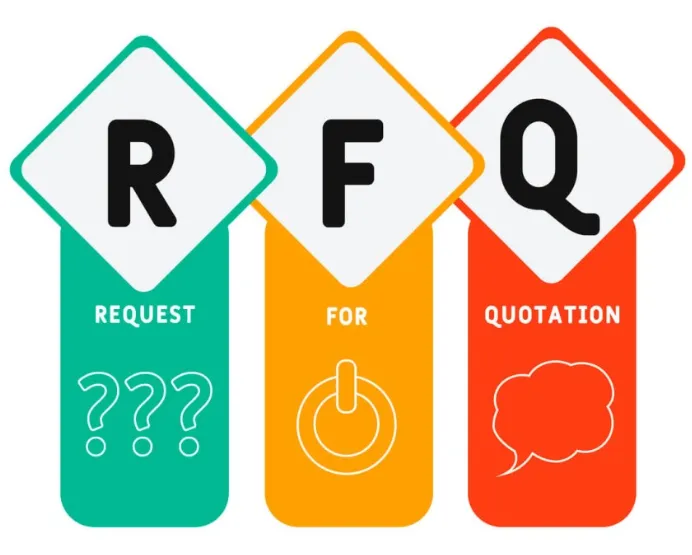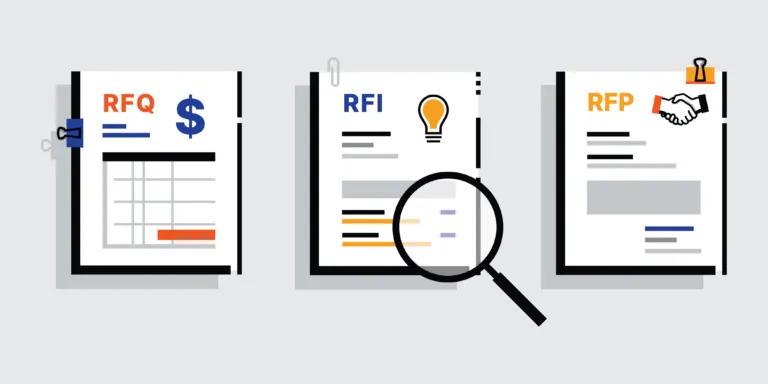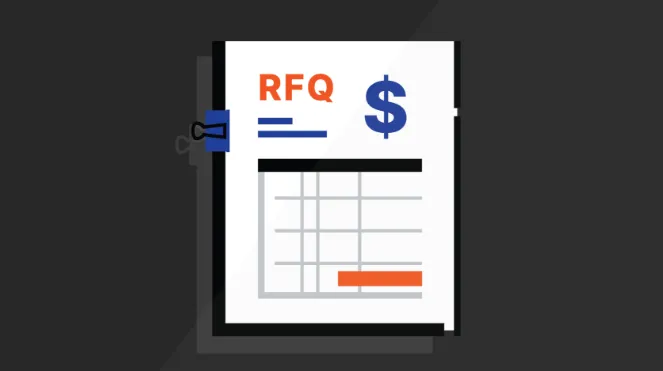The Ultimate Guide to RFQs in Procurement: The Process

You know the struggle. Getting clear, comparable quotes from suppliers shouldn’t feel like pulling teeth. Yet, vague requests lead to confusing offers, apples-to-oranges comparisons, and missed savings. The entire sourcing process bogs down.
What if you had a clear, professional system to cut through the noise? That system is the Request for Quotation (RFQ). This isn't just another procurement acronym. It's your most powerful tool for strategic, cost-effective buying of standardized goods.
This guide is your masterclass. We'll move beyond basic definitions into a detailed, professional playbook. You'll learn the precise RFQ process, how it differs from other requests, and walk away with a free, downloadable template to implement immediately.

An RFQ is not a casual price check. It's a formal, competitive bidding document used to invite selected suppliers to submit a firm price bid for specific, well-defined goods or services. The key here is specificity.
Think of it this way: you're not asking, "How much for a computer?" You're declaring, "I need to purchase 100 units of Laptop Model X, with 16GB RAM and a 512GB SSD, for delivery to our warehouse by June 30. Submit your best FOB price."
The core objective is fact-based, comparative cost analysis. It eliminates ambiguity and forces suppliers to compete on price and basic commercial terms for a known quantity and quality. It’s also known as an Invitation to Bid (ITB) or Invitation to Tender.
When its use is most powerful:
High-volume, low-complexity items: Standard parts, raw materials, office supplies.
Clear, unambiguous specifications: The exact make, model, technical standard, or blueprint is known.
Price as the primary driver: The main decision-making criterion is the total landed cost.
Ongoing needs: You're establishing contracts for repetitive purchases.

Using an RFQ when you need an RFP is like using a hammer to screw in a lightbulb. Professionals know the difference. This table is your cheat sheet.
|
RFI (Request for Information) |
RFQ (Request for Quotation) |
RFP (Request for Proposal) |
|
|---|---|---|---|
|
Purpose |
To gather market information and vet supplier capabilities. |
To obtain a firm price for a clearly defined item or service. |
To solicit innovative solutions to a complex business problem. |
|
Question Asked |
"What can you do?" |
"What will it cost?" |
"How would you do it and for what cost?" |
|
Specification Level |
Low. Exploratory. |
Very High. Precise and non-negotiable. |
Variable. Outcome is defined, but the solution is open. |
|
Key Evaluation Criteria |
Supplier competency, experience, and general fit. |
Price, payment terms, delivery schedule. |
Technical approach, value-add, team expertise, total cost of ownership. |
|
Best Used When |
Researching a new market or creating a vendor shortlist. |
Procuring commodities or standard goods where requirements are fixed. |
Sourcing complex services like software development, marketing campaigns, or consultancy. |
The Professional's Rule of Thumb: Use an RFQ when your requirements are set in stone, and you are solely negotiating on cost and terms. If the requirements themselves need a solution, you need an RFP.
A messy RFQ process yields messy results. Discipline and clarity are everything. Follow this professional six-step framework.

This is the most critical step. Rushing here guarantees problems later.
Internal Alignment: Collaborate with all stakeholders (engineering, finance, logistics) to finalize and agree on every technical and commercial requirement. No exceptions.
Build the RFQ Document: This must include:
Detailed Specifications: Part numbers, technical datasheets, blueprints, sample requirements.
Commercial Terms: Quantities, delivery location (Incoterms), desired payment terms, contract duration.
Evaluation Methodology: Clearly state how the bid will be awarded (e.g., lowest compliant bid).
Submission Format: Mandate the use of your pricing template for easy comparison.
An RFQ is typically sent to a pre-vetted pool of suppliers.
Quality over Quantity: It's not about sending it to 100 suppliers. It's about sending it to 5-10 highly qualified suppliers who have been pre-qualified for quality, financial stability, and reliability.
New Blood: Periodically introduce new potential suppliers to the process to ensure competitive tension.
Formal Issuance: Send the RFQ package simultaneously to all shortlisted suppliers with a clear, firm deadline.
Designated Q&A Channel: Establish a single point of contact and a formal window for suppliers to ask clarification questions.
Transparency is Key: Any question asked by one supplier, along with its answer, must be anonymized and distributed to allparticipating bidders. This ensures a perfectly level playing field.
Confidentiality & Discipline: All bids must be held securely and unopened until the stated deadline has passed. No exceptions.
Systematic Comparison: Use your standardized template to compare bids line-by-line. Look beyond the bottom-line price; analyze cost breakdowns, payment terms, and delivery dates.
Identify the Leader: Select the bid that best meets all mandatory requirements and offers the most advantageous price.
Clarification & Final Negotiation: This is not a re-bid. Engage with the top bidder to clarify any minor points and potentially negotiate final terms before awarding the contract via a formal Purchase Order (PO).
Notify Unsuccessful Bidders: Inform them promptly and professionally. Thank them for their time. This maintains strong relationships for future opportunities.
Internal Debrief: Document the process: number of bids received, issues encountered, and final savings achieved. This creates institutional knowledge for the next round.
When to Unleash an RFQ:
You are buying a standard or catalog item.
Exact specifications are known and will not change.
The quantity is known and significant enough to warrant a formal bid.
Your supplier base is pre-qualified for quality and reliability.
The Undeniable Advantages:
Cost Savings: Creates direct price competition among suppliers.
Efficiency & Speed: The structured process is faster than negotiating individually.
Transparency & Fairness: An objective process that is easy to audit and defend.
Standardization: Ensures you get exactly what you ask for.
The Professional's Caveats (Pitfalls to Avoid):
The "Low-Ball" Trap: Awarding based on price alone to a supplier who is incapable of delivering can be catastrophic. Quality pre-qualification is your shield.
Innovation Stifled: An RFQ does not solicit new ideas. You get exactly what you ask for, nothing more.
The "Split Order" Temptation: A common unethical practice is to break a large, complex project into smaller pieces to use RFQs and avoid a more rigorous RFP process. This leads to poor coordination and higher total risk.
Market Isolation: Solely using a closed list of existing suppliers can cause you to miss out on new, more innovative, or cheaper vendors.
The RFQ is the workhorse of strategic procurement. It’s not a mere document but a disciplined process designed to leverage your purchasing power and secure the best possible value for standardized goods. Its power lies in its clarity, structure, and ruthlessly objective focus on cost.
Mastering it is not optional for procurement professionals; it's essential. It builds a foundation of financial discipline, supplier management, and process integrity that pays dividends on every single purchase.
Q1: Is a submitted quote in response to our RFQ a legally binding offer?
A: Typically, yes. A properly submitted quote is generally considered a binding offer to supply the goods or services at the stated price. However, it is only converted into a formal contract when the buyer issues a Purchase Order (PO) based on that quote and the supplier accepts it. The terms and conditions within your RFQ are crucial in governing this process.
Q2: How do we handle an RFQ if there's only one qualified supplier for a specialized part?
A: This is a "sole source" procurement scenario. An RFQ is still valuable. It formally documents the cost negotiation, ensures commercial terms (delivery, payment) are agreed upon, and provides a paper trail for internal audits. You would negotiate directly with the single supplier but still formalize the agreement through the RFQ and PO process.
Q3: Can a supplier change their quote after submission but before the deadline?
A: Yes, most e-sourcing systems allow suppliers to amend their bids up until the closing time. This is standard practice to allow for corrections or last-minute cost updates. Once the deadline passes, the bid is typically locked and cannot be changed.
Q4: What's the best way to deal with a pricing error in a winning bid (e.g., a obvious miscalculation)?
A: This is a sensitive situation. The professional approach is to contact the supplier, point out the suspected error, and allow them to confirm or withdraw their bid. Awarding a contract based on a known error can lead to a disputed and dysfunctional supplier relationship. Your RFQ terms should include a clause on how mathematical errors are handled.
Q5: We received a bid significantly lower than others. Is this an automatic win?
A: Not automatically. A radically low bid can be a red flag. It may indicate the supplier misunderstood the requirements, is proposing substandard materials, has made a critical error, or is engaging in "low-ball" bidding to win the business with plans to raise prices later. It necessitates a thorough qualification and clarification process before award.
Q6: How specific should we be about the evaluation criteria in the RFQ?
A: Be transparent. While price is key, state if other factors will be considered, such as delivery speed, warranty length, or payment term flexibility. Even weighting these secondary factors (e.g., "Price 80%, Delivery Date 20%") is a best practice. Transparency reduces disputes and ensures suppliers know what to optimize for.
Q7: Is it ethical to use the lowest submitted quote to negotiate with our preferred (but more expensive) supplier?
A: This is considered highly unethical if done after bids are closed. It undermines the competitive process and can damage your reputation. If you have a preferred supplier, negotiate with them beforeissuing the final RFQ. The bidding process itself should be a fair and honest competition.
Q8: What happens if no suppliers meet our specified requirements in their quotes?
A: You have two main options: 1) Re-issue the RFQ with clarified or potentially relaxed specifications, or 2) Enter into negotiations with the closest compliant bidder to see if a solution can be found. You are not obligated to award a contract if no bid meets the mandatory requirements.
Q9: Beyond Excel, what tools do professionals use to manage the RFQ process?
A: Larger organizations use dedicated e-sourcing or e-procurement platforms (e.g., SAP Ariba, Coupa, Fairmarkit). These systems automate the entire process: distributing documents, hosting a secure Q&A portal, conducting reverse auctions, and providing analytical tools for bid analysis, all while ensuring audit compliance.
Q10: How can we prevent "bid shopping" – using our quotes to get a better deal elsewhere?
A: This is a risk when working with agents or distributors. The best mitigation is to include strong confidentiality and "No-Bid-Shopping" clauses in your RFQ terms and conditions. Building long-term, trusted relationships with tier-1 suppliers also minimizes this risk.
Q11: Should we provide feedback to unsuccessful suppliers who ask for it?
A: Absolutely. Providing constructive, generic feedback is a hallmark of professional procurement. It helps suppliers understand your decision and improve their future offers. Keep it high-level—e.g., "Your pricing was non-competitive on the main unit items," or "A competitor offered more favorable payment terms." Avoid sharing specific competitor data.
Q12: Can an RFQ be used for services, or is it only for goods?
A: It can be used for standardized, repetitive services where the output is clearly defined. Examples include janitorial services, lawn maintenance, or bulk printing services. If the service requires creative input, specialized expertise, or variable solutions, an RFP is the far more appropriate tool.
Contact us
Call Us: +86 193 7668 8822
Email:[email protected]
Add: Building B, No.2, He Er Er Road, Dawangshan Community, Shajing Street, Bao'an District, Shenzhen, China